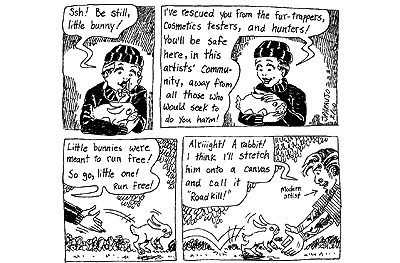| Free the Web Napster.com is a Web site that allows Internet users to download and trade MP3s with other Napster users. Students use Napster because they can go into this site and download their favorite songs free of charge. However, despite the popularity of Napster, Assistant Provost for Information Services David Edmondson decided to shut down access to Napster.com last week. Edmondson banned the use of this site because the university's bandwidth, which was doubled in November, has become saturated by the site. "It was slowing people down when they were trying to use the Internet," he said. "That is when we decided to simply block students from using the program, thus freeing up our bandwidth for other uses." However, the Internet is not just an educational tool. It serves as a recreational tool, as well. When students download music to their computers, it is simply an easy and inexpensive way of providing entertainment. TCU students pay to have Internet access at this school. Therefore, they should be able to use the Internet in this harmless manner. The Internet is a free medium for the public, and the university should not have the right to take any part of it away. Instead, the university should look into ways of solving the problems caused by Napster. Napster is currently working with the University of Indiana to solve the problem, and TCU administrators should follow their lead. Until then, the university shouldn't deny students the right to use Napster and, instead, work as quickly as possible to stamp out existing problems.
Goldfish blending is cruel, not art But is it art? That is the question being asked at an art exhibit in Copenhagen, Denmark, in which goldfish are swimming in blenders filled with water. Did anyone actually turn the blenders on, you ask? So far, seven goldfish have been sacrificed for art. What was the point of this purée performance art? The museum's director, Peter Meyer, stated, "We have abortions, and we have respirators where we choose whether to keep people alive or not. We have become rulers of the decision on life and death in a new way." That point was symbolized with goldfish in blenders and giving the visitors the option of exercising control over the goldfish's life. What a bone-headed idea for art. Of course some sicko was going to turn the darn thing on! Fortunately, all the blenders have now been disconnected, but it's a little late for seven of those little critters. Last fall, there was a flap over an exhibit in the Brooklyn Museum of Art over some animals that were dissected and displayed. Among the animal art exhibits were a rotting cow's head, a formaldehyde-suspended bisected pig and an enormous shark suspended in formaldehyde. What is it with modern artists and animal cruelty nowadays? Some years back, much was made by animal rights activists over fur-trappers and how their steel traps were cruel to animals caught in them. Following that were protests over the whaling industry. Next came the protests over the clubbing of baby seals. Then the use of animals for cosmetics testing was protested. All during the '80s and into the '90s, we were told of numerous accounts of animal cruelty. Apparently, however, animal rights activists should have been preaching their messages to modern artists. Perhaps it is an example of how far art has fallen. Paint on canvas no longer seems to be a sufficient medium for some modern artists to present their message. No, now these artists must use animal remains in their art to continue to draw our attention. Which leads to the question of why shocking our sensibilities seems to be so important to these artists. I suspect that there are issues from childhood that they haven't yet resolved. Or maybe they are trying to hide the fact that they just don't have any artistic talent! Whatever happened to art that was meant to enlighten our minds and expand our horizons? If you want such art today, you have to go to a more traditional art museum. Fortunately, such art still exists and is still appreciated. Don't get me wrong. Some modern art is good, and I can appreciate a work in which some thought is actually put into it. However, some modern art looks too much like the work of lazy artists in which objects lying around were slapped together, and a story was built around it. Even worse is artwork that looks like something from a slasher movie. An artist whose only goal is to shock and disgust us with no real underlying message is someone who never got past the finger-painting stage in elementary school art class in which he made a handprint of his middle finger extended. What we should be worried about, however, is what these artists will use next when dissected animals no longer shock us. Can live animal sacrifices be far behind? Could the use of goldfish in a blender be seen as a harbinger? It's a strange world when Atlanta Braves pitcher John Rocker is made to undergo psychiatric evaluation for his trashy mouth, but individuals who use animal remains (or live fish!) in their trashy art are regarded as "artists who are exercising their First Amendment rights." Does the right to the freedom of expression extend to use of animal parts, or are there some limitations on what can and can't be used as a medium for artists? That is a question that we need to answer before making any more of our animal friends into the latest art exhibit.
John P. Araujo is an MLA graduate student
from Fort Worth. True American hero should be elected president Everything in Texas, from the way people talk, dress, interact and live their lives took a little getting used to. But I soon realized conservatives weren't as bad as I had built them up to be in my self-proclaimed liberal mind-set. When I started following the politics of Texas Gov. George W. Bush, I welcomed the idea that he might be the man to bring this conservatism to the rest of the nation. The entire United States would become one giant, Bible-thumping, love-your-neighbor-as-yourself, successful America, and everybody would be happy. That was what I thought until George W. made the mistake of insulting supporters like me by speaking at Bob Jones University in Greenville, S.C. The 5,000-student fundamentalist Christian university bans interracial dating and forbids visits to the school by gay alumni. Sure, Bush made the speech in the wake of John McCain's 19-point New Hampshire primary upset, but I hardly think his campaign was damaged so badly that he needed to secure the votes of people who are contributing to the continuing problem of bigotry in the United States. I wondered if this could possibly be true. A university that promotes bigotry? A presidential candidate, excuse me, the leading presidential candidate, speaking there? The fact that these events occurred led me to one conclusion: If I am going to vote based on character rather than issues, I really need to find out what these candidates are about. So, I started researching, and I found a hero. He is a man who stands up for what he believes, who isn't afraid to tell people what he has to say (even if they aren't prepared to hear it) and who opens the door to his closet so that all may see his skeletons. He is a man who deserves to be president of the United States. His name is John McCain. He doesn't have Bush's money, he doesn't have as many friends, and he doesn't even own a ranch (gasp!). But he is an American legend. This is a man who spent 5 1/2 years as a prisoner of war, refused to come home and leave his fellow prisoners behind and then served more than 10 years in Congress. Growing up, I learned about great, heroic men who were presidents of the United States. Today, we often settle for the most honest or the candidate who can brown-nose the most constituents. It's time for us to elect a president who will be a hero for this country. Winning the presidency may be a long shot for McCain, but at least I'll be able to tell my kids about the year 2000 when a real, live American hero sought the presidency of the United States.
James Zwilling is a freshman news-editorial
journalism major from Phoenix. Letter to the editor In response to Friday's "Some question safety on University Drive," I am opposed to any additional traffic restrictions. Before we petition the city of Fort Worth for a set of speed bumps or another traffic light, I think we should remember that University Drive, besides being a treacherous division to our pedestrian traffic, is first a heavily trafficked public road. I have friends at public schools like the University of Texas and Texas A&M University that walk or cycle through real traffic to get from class to class.What about the traffic in a hurry to drive through our stretch of campus? Add a third traffic light, and we will have 5 p.m. traffic backed up to the zoo. I think it is time to do a little growing up and accept the fact that crossing a busy road will always include a certain amount of danger. If pedestrians choose to cross outside of the red light cycle of our crosswalk, it is their responsibility to look both ways. I don't think that further traffic restrictions could ever prevent these accidents. Kevin Thompson sophomore business major Students speak out
-Tia Beck, freshman premajor
-Brandy Schaefer, freshman dance major
-Kevin Long, sophomore criminal justice major
-Brad Simmons, sophomore radio-TV-film major
-Joey England, freshman biology major
-Sarah Board, freshman biology & Spanish major |
The TCU Daily Skiff © 1998, 1999 Credits |

 "I'd like to see George Strait in concert because he's
a big name and usually has really good concerts that I'd like to see."
"I'd like to see George Strait in concert because he's
a big name and usually has really good concerts that I'd like to see." "I'd like PC to bring Ani DiFranco
because I really like her music, and I like the message that she sends."
"I'd like PC to bring Ani DiFranco
because I really like her music, and I like the message that she sends." "I'd like 311 brought to TCU because they're an awesome
band and because I love their music. They're the band of the '90s and the
band of the new millennium."
"I'd like 311 brought to TCU because they're an awesome
band and because I love their music. They're the band of the '90s and the
band of the new millennium." "I want (PC) to bring the Cure because
they're a really good band. They're absolutely amazing, and they are a
euphoric experience."
"I want (PC) to bring the Cure because
they're a really good band. They're absolutely amazing, and they are a
euphoric experience." "I'd like to see more Christian bands to come and play
at TCU because I like to hear the Word praised."
"I'd like to see more Christian bands to come and play
at TCU because I like to hear the Word praised." "I think we should get the Backstreet Boys because
they have good music, and a lot of people would come to a concert like
that."
"I think we should get the Backstreet Boys because
they have good music, and a lot of people would come to a concert like
that."